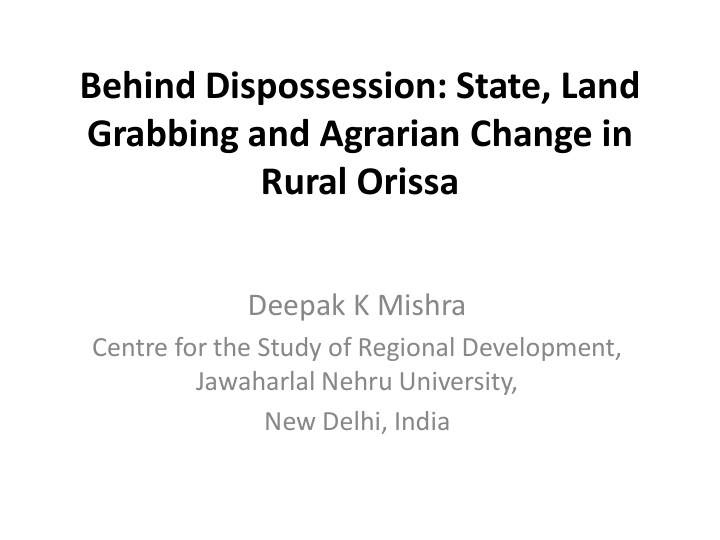



Behind Dispossession: State, Land Grabbing and Agrarian Change in Rural Orissa Deepak K Mishra Centre for the Study of Regional Development, Jawaharlal Nehru University, New Delhi, India
Land Grabbing as ‘Foreignisation of Space’ • Global dimensions of land grabbing- cross- border transfer of property rights, a significant phenomenon - not the only way land grabbing is carried out • Land Grabbing as ‘primitive accumulation’- multiple forms of land grabbing and dispossession • linkages between catastrophic land grabbing and the classic processes of land alienation
Poverty, Hunger and Underdevelopment in Orissa: The Context • Orissa -the poorest state in India; it is at the bottom in terms of many indicators of social and economic development. • Slower decline in poverty. • Poverty is spatially and socially concentrated in Orissa- Districts of Northern and Southern Orissa have higher incidence of poverty; SCs and STs have remarkably higher levels of poverty • Historical roots of poverty
Orissa (Odisa)
History: Colonial Period • Interior Orissa under princely states: predominantly tribal • Efforts to raise revenue by inviting upper caste cultivators and traders; land alienation from tribals to upper castes • Curtailment of community rights over forests, grazing lands and water bodies • new taxes over forest products; tribal uprisings
Post-independence developments • Feudal lords as new leaders of the people, landed elites maintained their hold over the agrarian economy • Development projects (Dams, steel plants); large scale involuntary displacement; poor compensation • Low agricultural investment, low productivity • Slower growth of rural non-farm economy • Massive deforestation by state agencies and corporate houses • By 1980s: Kalahandi-Balangir-Koraput region came to be known as the ‘hunger belt’
Dispossession-in-slow-motion: Agrarian Change in Orissa • pre-dominantly small-holder’s agriculture: (85% were marginal less than a hectare of land in 2003) • tenancy is higher than the national average (13.15%, 2003) Field Survey: 1999-2000 • a neat correspondence between land- ownership status and caste-status • land-lease market was found to be dominated by small and marginal farmers
Agrarian Change • Labour relations: permanent labour contracts present but declining; segmented casual labour market- by gender, tasks; piece rate contracts with migrant labour in irrigated villages • various forms of ‘unfreedom’ in labour market • Exploitative informal credit; interlocked transactions: • Sources of credit: shopkeepers, moneylenders, grain traders and input-dealers • Caste (Dalit or ST), low land ownership, low education and less access to non-farm income significantly related to participation in exploitative interlinked transactions
Field Survey: 2010 • Declining profitability of paddy cultivation . (water shortages, less reliable and timely supply of water through the canal system, increase in prices of inputs such as fertilizer and pesticides, under- pricing of paddy in the post harvest period, and finally a rising cost of labour). • Labour out-migration, both seasonal and long-term increased- a large number of small and marginal cultivator families are simply unable to survive without short-term migration or remittances from members who have already migrated. • Inadequate state support: Employment Guarantee not enough • Elements of coercion (implicit and explicit)
Neoliberalism meets Chronic Poverty • Mining and mineral based industries as the basis for market-led economic growth- infrastructure (linking industries with ports or railway networks) • Privatisation of electricity and other utilities • Development model under neo-liberalism: states competing against each other to attract foreign and domestic capital • New concessions- land, raw materials, water, infrastructure; environmental concession
From A report by Brand Equity Foundation of India
Development as Dispossession Land grabbing in Orissa: different forms and for different purposes • mining, industrial, and infrastructural projects (Kashipur, Niyamgiri, Kalinganagar, Jharsuguda), including SEZs (POSCO); • military projects (Saintala) • Construction of dams (Upper Kolab, Indravati, Lower Suktel and many others) • Conversion of forest lands to agro-industrial plantations (Coffee plantations in Koraput); • state-initiated enclosures for conservation projects • illegal enclosures by non-state actors.
Land Grabbing as Primitive Accumulation • Role of state power crucial in the on-going process of primitive accumulation • relaxation of environmental regulations, non- compliance with standard norms and statutory provisions, submission of misleading and false information • Development as mining and industrialisation; dispossession as the price of development • Violent suppression of dissent (routine police brutality) • Role of local elites (a rentier class?): legitimizing primitive accumulation- non-state/ informal sources of coercive power
Role of State and Non-State actors… • Action against civil society groups, NGOs, individuals- deregistration, physical attacks • Maoist insurgency and movements against displacement: increased attention but increased repression as well • State and Central governments: Vedanta/ Niyamgiri case- environmental clearance as centre-state conflict • Conflicts over water: farmers against industry
Concluding Remarks…. • Global dimensions of cross-border land transfer a significant phenomena, but it is on-going primitive accumulation under globalisation • accumulation-by-dispossession not limited to displacement of people from land through coercive state action. • dispossession through gradual, but systematic undermining of resources upon which the poor depend also significant – these two forms are linked and often mutually reinforcing.
Recommend
More recommend